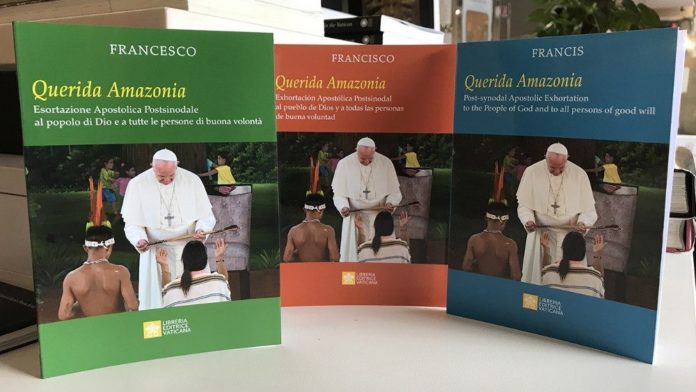(from the Alphonsian Academy Blog)
So far the reactions have been immediate and varied. Not without a burden of disappointment, especially for those who might expect revolutionary twists in the Church. We are talking about reactions rather than receptions, and this is already a key, but a symptom.
We find, with out doubt, a well-structured text, beautiful in its narrative, by poetic moments, incisive and no less hopeful (text of exhortación). As utopian as it is dystopian. So full of dreams and possible sapiential paths incarnates and integrators, liberators, that they are projected with realism wanting to open horizons of hope, for and from a reality that is the clamor of life and pain.
The Pope, who offers these reflections as complementary to the Final Document of the Synod (cf. QA,nn. 2-3), therefore without taking away or denying any authority, continues to bet on a synodal and ecclesial walk, where the novelties and responses to the cries of life do not come from “above” but will be the fruit of walking together, making the Kingdom in the here and now of history, seeking to cultivate that creative faithfulness that have so much taste of the Gospel and so much aroma to the Spirit, which always makes all things new.com. QA, n. 69). From this option, the pope addresses “everyone”(QA,n. 5), so his utensils cannot and should not be centered on ecclesiastical navels. What does not take away from the continued number of ecclesial debts, subjects that hope to be treated and taken on with evangelical seriousness. How to continue to discern the sacramentality and ministeriality of the Church from more evangelical, inculturated, ecumenical and interreligious perspectives.[i]
The pope expresses his four dreams, his deepest yearnings as a shepherd who come not by imagination but by inspiration from the reality of the Amazon herself, and does so with the clear conviction that “everything that the Church offers must be embodied in an original way in every place of the world so that the Wife of Christ acquires multiform faces that better manifest the inexhaustible richness of grace”(QA,n. 6). These dreams span four dimensions: social (QA, nn. 8-27); (QA,nn. 28-40); (QA,nn. 41-60); (QA,nn. 61-110). We see that the first three tops the list and have a certain proportion in terms of the number of numerals, that is justified because we are looking at a document of the social magisterium, in clear continuity with Laudato si’, and also by the universal recipients, as we said. On the other hand, it does not go unnoticed that the ecclesial dimension, even though it is the last, occupies the largest space and that the pope wants to “share more directly with the Catholic pastors and faithful”(QA,n. 60).
We do not have here the space to analyze each of these dimensions, its accents and possible novelties. So, at the general level, it seems clear to us that the central concern is to denounce and alert about all possible forms of “colonization”,[ii]in the face of this terrible reality that continues to jeopardize the “integral ecology” (QA,nn. 1; 58) an evangelizing [iii] response mediated by an [iv] incarnate [v] and inculturated [vi] proclamation is offered through the exercise of dialogue [vii] at all levels. Because, on the one hand, “at the present time the Church cannot be less committed, and is called to listen to the cries of the Amazonian peoples”, on the other hand, “social struggle implies a capacity for fraternity, a spirit of human communion”(QA,nn. 19-20).[viii] Assume each of these expressions. On the other hand, it is necessary to dream, to design, an “educational task” that knows how to “cultivate without uprooting, to grow without weakening identity, to promote without invading”(QA,n. 28). This requires, among other things, to awaken “the aesthetic and contemplative meaning that God put in us and which we sometimes let atrophy”(QA,n. 56).
In short, the pope’s bet, that invites us to make our own, is[ix] to continue to opt “for the poorest and most forgotten”. For those, who can receive neither “a code of doctrine or a moral imperative” nor a mere “social message”. We are invited to continue to struggle side by side with them and for them “because we recognize Christ in them and because we discover the immense dignity that the Father God who loves them infinitely gives them” (QA, nn. 63; 105; 110). The dreams have been shared, the horizon remains open, and the only thing left to do is to make concrete paths with prophetic height and wisdom.
The Blog’s Editorial Staff
[i] Cf. QA, nn. 84-90; 92-94; 106-110.
[ii] Cf. QA, nn. 9; 14; 16-18; 28-30; 39.
[iii] Cf. QA, nn. 71; 75; 78; 104.
[iv] Cf. QA, nn. 61; 63-65; 68; 72; 96.
[v] Cf. QA, nn. 6; 7; 60-61; 69; 74; 77; 85; 95; 105.
[vi] Cf. QA, nn. 66; 68-70; 72-73; 75-76; 78; 81-82; 85; 95: 105.
[vii] Cf. QA, nn. 2; 26-27; 37-38; 66; 90; 95; 101; 108.
[viii] Cf. QA, nn. 12; 20; 26; 53; 62; 72; 77; 108; 109; 110.
[ix] Cf. QA, nn. 7-8; 13; 16-17; 27; 52; 63; 72; 75-76; 84; 98; 106; 110.
Source: text&photo – http://www.alfonsiana.org; the original text is in Spanish.






